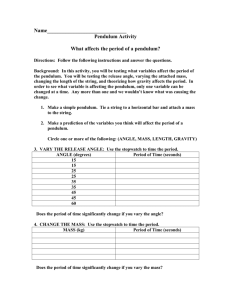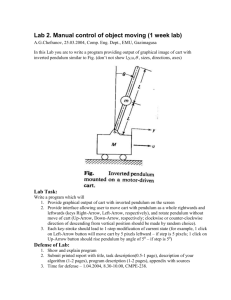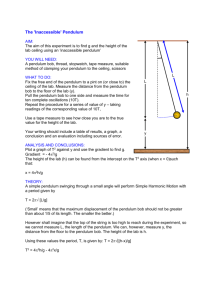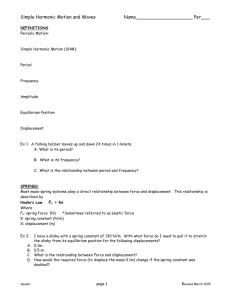TAP304-0: Simple pendulum
advertisement
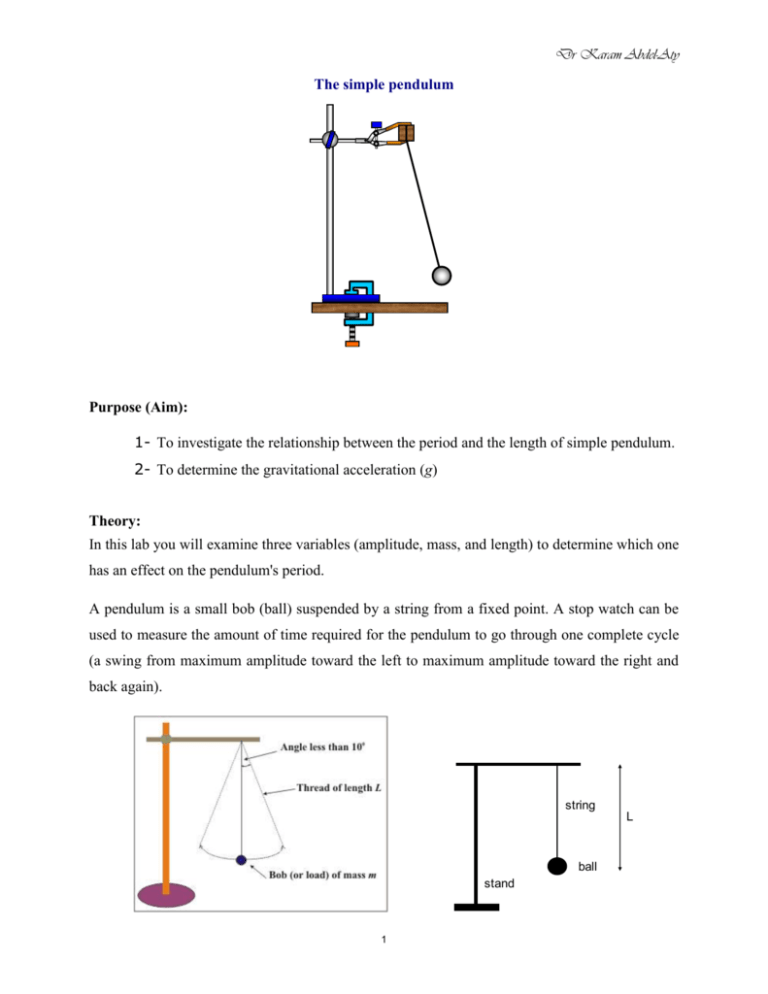
Dr Karam Abdel-Aty The simple pendulum Purpose (Aim): 1- To investigate the relationship between the period and the length of simple pendulum. 2- To determine the gravitational acceleration (g) Theory: In this lab you will examine three variables (amplitude, mass, and length) to determine which one has an effect on the pendulum's period. A pendulum is a small bob (ball) suspended by a string from a fixed point. A stop watch can be used to measure the amount of time required for the pendulum to go through one complete cycle (a swing from maximum amplitude toward the left to maximum amplitude toward the right and back again). string ball stand 1 L Dr Karam Abdel-Aty Many things in nature wiggle in a periodic fashion. That is, they vibrate. One such example is a simple pendulum. If we suspend a mass at the end of a piece of string, we have a simple pendulum. Here, the to and fro motion represents a periodic motion used in times past to control the motion of grandfather and cuckoo clocks. Such oscillatory motion is called simple harmonic motion. It was Galileo who first observed that the time a pendulum takes to swing back and forth through small distances depends only on the length of the pendulum The time of this to and fro motion, called the period, does not depend on the mass of the pendulum or on the size of the arc through which it swings. Another factor involved in the period of motion is, the acceleration due to gravity (g), which on the earth is 9.8 m/s2. It follows then that a long pendulum has a greater period than a shorter pendulum. The motion of a simple pendulum swinging can be described as a harmonic motion. The period of this motion T is: L g Where L is the length of pendulum string and g is the acceleration due to gravity. T 2 If we solve last formula for gravity g: 4 2 L g T2 So the data from this experiment could be used to calculate the gravity also. The period T of the simple pendulum (measured in seconds) is given by the formula: T=2 π √ (L/g) (1) T = time for 20 oscillations/ 20 oscillations (2) using equation (1) to solve for “g”, L is the length of the pendulum (measured in meters) and g is the acceleration due to gravity (measured in meters/sec2). Now with a bit of algebraic rearranging, we may solve Eq. (1) for the acceleration due to gravity g. (You should derive this result on your own). g = 4π².L/T2 (3) Apparatus / Materials: A string used as a rigid rod Cotton thread A mass (small pendulum bob) metre ruler 2 Dr Karam Abdel-Aty Table clamp A rod on which the mass is fixed Stopwatch Ruler Procedure: 1. Set up a small simple pendulum, as shown in the diagram. 2. Measure the length of the pendulum to the middle of the pendulum bob. Record 3. Keeping the angle of swing, less than 10o, for at least 4 lengths of the pendulum, L between 20cm and 100cm, measure the period of swing, T. 4. set the pendulum in motion until it completes 20 for a certain time, taking care to record this time. Then the period T for one oscillation which is just the time number recorded divided by 20 using (eq. 2). 5. Repeat the previous steps and record the results in a table as shown below. 6. Plot a graph of T2 against L. 7. For a small angle ; T = 2 (L / g) where g is the acceleration due to gravity. 8. The gradient of your graph is equal to 42 / g. 9. Measure your gradient and use it to calculate a value of g. Note that: π = 3.14, 4 π² = 39.44 3



